Plot
Faced with mortgage debts, Professor Nathaniel Billings (Boris Karloff) sells his 18th-century tavern to Winnie Layden (Jeff Donnell), who plans to turn it into a hotel. Billings stipulates as a condition of sale that he is able to continue working in a laboratory in the basement. His housekeeper Amelia Jones (Maude Eburne) and hired hand Ebenezer (George McKay) also continue to work in the inn. Layden is initially unaware of the nature of Billings's experiments in the basement laboratory: he is attempting to use electricity to create a race of superhumans to help the war effort. Layden's ex-husband Bill (Larry Parks) is against the sale, but is too late to stop it, and decides to stay on at the inn for a few days.
One night at dinner, the residents hear the sounds of a ghost. Bill suspects that this is part of a plan to scare the new owner away. While investigating, Bill discovers in the basement the dead body of travelling salesman Johnson (Eddie Laughton), an experiment subject who died shortly after the sale. He reports this discovery to the local sheriff Dr. Arthur Lorencz (Peter Lorre). After making inquiries, Lorencz realises the potential for profit and decides to work with Billings on a subsequent experiment. Their initial plan is to use Bill as a test subject, but this proves unsuccessful, so they turn their attention to Maxie, a visiting powder puff salesman (Maxie Rosenbloom).
Before the experiments can begin, one of the inn's guests is murdered. Billings and Lorencz see the primary suspect as another guest, J. Gilbert Brampton (Don Beddoe), but the police officers who set out to investigate are intercepted on the way. Maxie scares away an intruder known as "Jo-Jo" (Frank Puglia), who is intending to steal Billings's equipment. Billings and Lorencz decide to begin their experiment on Maxie so that they can use him to stop "Jo-Jo" from blowing up a nearby munitions plant. Meanwhile, Brampton informs Winnie and Bill that he is visiting as a representative of the Historical Society of America, who are interested in buying the inn.
When the police officers eventually arrive, they arrest the housekeeper and Ebenezer for the murders. The dead bodies come back to life, having apparently been in a state of suspended animation. The police officers decide to send the rest of the house's inhabitants to the Idlewild Sanatorium, a local psychiatric institution. [2] [3]
Production
The Boogie Man Will Get You was the final film that Boris Karloff made under his contract with Columbia, and the studio were hoping to build on the success of the Broadway play Arsenic and Old Lace , which Karloff was appearing in at the time. [2] [4] [3] Production of the film took place while the play was on hiatus in summer 1942. [3] There are many similarities between the film and Arsenic and Old Lace, including the presence of eccentric characters and the premise of dead bodies in the basement. [3] [5] As previously with the films he made with Columbia, Karloff was cast in the role of a "mad scientist", as he had been in films such as The Man They Could Not Hang (1939), Before I Hang (1940), The Man with Nine Lives (1940), and The Devil Commands (1941). [6]
The screenplay was written by Edwin Blum in four weeks, [7] based on a story by Hal Fimberg and Robert B. Hunt, adapted by Paul Gangelin. [8] Although the film is a comedy-horror, Blum described the studio's aims as creating a "goose pimple" film; Blum explained that he "was and still [is] incapable of writing a straight horror film". [7] Before filming began, Jack Fier had been named as the producer, but Colbert Clark took over from him. [9] [2]
The set for the laboratory and its exotic scientific equipment initially was to include a visible woman, a clear live-sized plastic figure "with lights denoting various nerve-centers," but this was dropped after the Production Code Administration, which enforced the "no nudity in fact or in silhouette" prohibition of the Motion Picture Production Code, raised questions regarding this transparent unclothed model. [10]
Columbia planned a publicity campaign to promote the film, polling film critics to compile a list of the ten best on-screen villains. The studio assumed that Karloff and Lorre would come high on the list, but the top three were all Disney characters: the witch from Snow White and the Seven Dwarfs , the wolf from Three Little Pigs , and the cat from Pinocchio . The studio consequently abandoned this publicity idea. [3] [11]

The mad scientist is a stock character of a scientist who is perceived as "mad, bad and dangerous to know" or "insane" owing to a combination of unusual or unsettling personality traits and the unabashedly ambitious, taboo or hubristic nature of their experiments. As a motif in fiction, the mad scientist may be villainous or antagonistic, benign, or neutral; may be insane, eccentric, or clumsy; and often works with fictional technology or fails to recognise or value common human objections to attempting to play God. Some may have benevolent intentions, even if their actions are dangerous or questionable, which can make them accidental antagonists.

Peter Lorre was a Hungarian and American actor, active first in Europe and later in the United States. He began his stage career in Vienna, in the Austro-Hungarian Empire, before moving to Germany where he worked first on the stage, then in film in Berlin in the late 1920s and early 1930s. Lorre caused an international sensation in the Weimar Republic-era film M (1931), directed by Fritz Lang, in which he portrayed a serial killer who preys on little girls.

William Henry Pratt, known professionally as Boris Karloff and occasionally billed as Karloff the Uncanny, was an English actor. His portrayal of Frankenstein's monster in the horror film Frankenstein (1931) established him as a horror icon, and he reprised the role for the sequels Bride of Frankenstein (1935) and Son of Frankenstein (1939). He also appeared as Imhotep in The Mummy (1932), and voiced the Grinch in, as well as narrating, the animated television special of Dr. Seuss' How the Grinch Stole Christmas! (1966), which won him a Grammy Award.
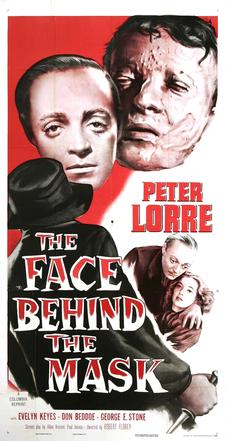
The Face Behind the Mask is a 1941 American film noir crime film directed by Robert Florey and starring Peter Lorre. The screenplay was adapted by Paul Jarrico, Arthur Levinson, and Allen Vincent from the play Interim, written by Thomas Edward O'Connell (1915-1961).

The Raven is a 1963 American comedy gothic horror film produced and directed by Roger Corman. The film stars Vincent Price, Peter Lorre, and Boris Karloff as a trio of rival sorcerers. The supporting cast includes Jack Nicholson as the son of Lorre's character.
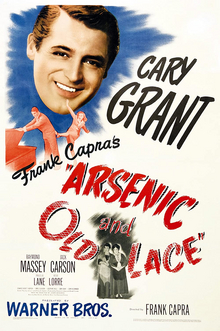
Arsenic and Old Lace is a 1944 American screwball mystery black comedy film directed by Frank Capra and starring Cary Grant. The screenplay by Julius J. Epstein and Philip G. Epstein is based on Joseph Kesselring's 1941 play of the same name. The contract with the play's producers stipulated that the film would not be released until the Broadway run ended. The original planned release date was September 30, 1942. The play was hugely successful, running for three and a half years, so the film was not released until 1944.

Arsenic and Old Lace is a play by American playwright Joseph Kesselring, written in 1939. It has become best known through the 1944 film adaptation starring Cary Grant and directed by Frank Capra.

The Black Cat is a 1934 American pre-Code horror film directed by Edgar G. Ulmer and starring Boris Karloff and Béla Lugosi. It was Universal Pictures' biggest box office hit of the year, and was the first of eight films to feature both Karloff and Lugosi. In 1941, Lugosi appeared in a comedy horror mystery film with the same title, which was also named after and ostensibly "suggested by" Edgar Allan Poe's short story.
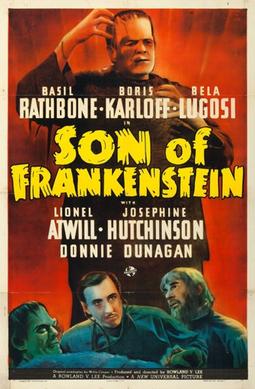
Son of Frankenstein is a 1939 American horror film directed by Rowland V. Lee and starring Basil Rathbone, Boris Karloff and Bela Lugosi. The film is the third in Universal Pictures' Frankenstein series and is the follow-up to the 1935 film Bride of Frankenstein. Son of Frankenstein stars Rathbone as Baron Wolf von Frankenstein who, with his wife Elsa and son Peter, returns to his late father's estate. Near the castle lives Ygor, a crazed blacksmith whose neck was broken in an unsuccessful hanging attempt. Among the castle's remains, Frankenstein discovers the remains of the Monster and decides to try to save his family name by resurrecting the creature to prove his father was correct. He finds, however, the Monster only responds to Ygor's commands.

Boris Karloff (1887-1969) was an English actor. He became known for his role as Frankenstein's monster in the 1931 Frankenstein, leading to a long career in film, radio, and television.
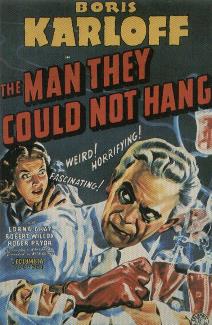
The Man They Could Not Hang is a 1939 American horror film directed by Nick Grinde from a screenplay by Karl Brown. It stars Boris Karloff as Dr. Henryk Savaard, a scientist who develops a procedure for bringing the dead back to life. When he is arrested and sentenced to be executed for murdering a young medical student who volunteered to be killed to test the procedure, Savaard vows retribution on the individuals responsible. Alongside Karloff, the film's cast includes Lorna Gray, Robert Wilcox, and Roger Pryor.

The Comedy of Terrors is a 1963 American International Pictures horror comedy film directed by Jacques Tourneur and starring Vincent Price, Peter Lorre, Basil Rathbone, Boris Karloff, and Joe E. Brown in his final film appearance. It is a blend of comedy and horror which features several cast members from Tales of Terror, made by AIP the year before.
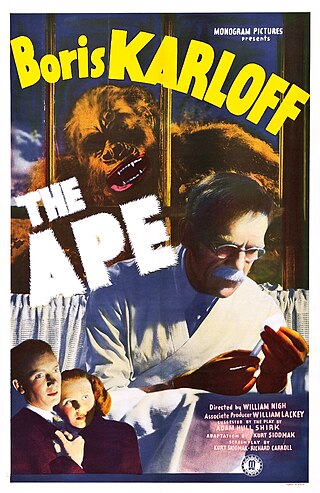
The Ape is a 1940 American horror film directed by William Nigh. The film is based on Adam Hull Shirk's play The Ape, which was previously adapted by Nigh as The House of Mystery (1934). The film stars Boris Karloff as Dr. Bernard Adrian who is seeking to cure a young woman's polio through experiments involving spinal fluid. Meanwhile, a vicious ape has been terrorising the towns locals, and breaking into Adrian's lab. A battle ensues between the two leading to Adrian deciding to skin the ape and disguise himself as the beast in order to get more spinal fluid which was destroyed in the battle.

The Ape Man is a 1943 American horror film directed by William Beaudine. The film is based on "They Creep in the Dark" by Karl Brown, which was published in The Saturday Evening Post. It stars Bela Lugosi as Dr. James Brewster who is aided by his colleague Dr. Randall. The doctor manages to transform himself into a ape man hybrid and desperately seeks a cure. Brewster believes that only the injection of human spinal fluid will prove effective as a cure. As Randall refuses to help him, Brewster and his captive gorilla seek involuntary donors.

Before I Hang is a 1940 American horror film released by Columbia Pictures, starring Boris Karloff. The film was directed by Nick Grinde and was one of several films Karloff starred in under contract with Columbia.
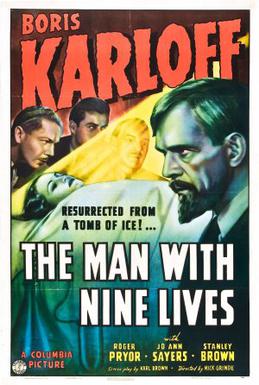
The Man with Nine Lives is a 1940 American horror science fiction film directed by Nick Grinde and starring Boris Karloff.

The Devil Commands is a 1941 American horror film directed by Edward Dmytryk and starring Boris Karloff. The working title of the film was The Devil Said No. In it, a man obsessed with contacting his dead wife falls in with a sinister phony medium. The Devil Commands is one of the many films from the 1930s and 1940s in which Karloff was cast as a mad scientist with a good heart. It was one of the last in line of the low-budget horror films that were produced before Universal Studios' The Wolf Man. The story was adapted from the novel The Edge of Running Water by William Sloane.

Snake People a.k.a. Isle of the Snake People, is a 1968 Mexican horror film directed by Juan Ibáñez and starring Boris Karloff and Julissa.

The Incredible Invasion, also known as Alien Terror, is a 1968 Mexican science fiction film directed by Luis Enrique Vergara. It stars Boris Karloff, Yerye Beirute and Enrique Guzmán. It is the last film Karloff worked on before his death in 1969. It was filmed in May 1968, but was only released theatrically in 1971, 2 years after Karloff had died.
Olive Sturgess is a Canadian former actress who worked in films, television shows, and theatre in the 1950s and 1960s. Her parents were Mr. and Mrs. Leonard Sturgess. Leonard hosted his own radio show. She came to Hollywood in 1954.



















